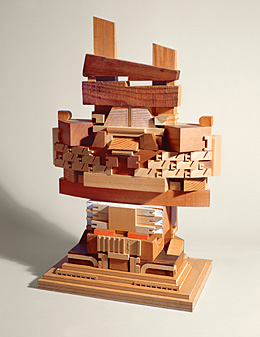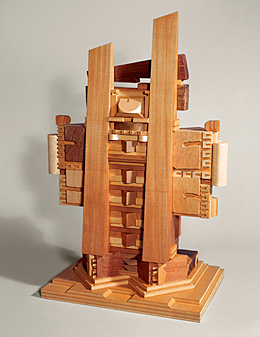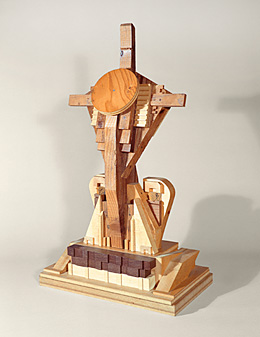“Self-Portraits” January 5 – February 23, 1990
Syntex Gallery, 3401 Hillview Avenue, Palo Alto, CA
Expanded from an artist’s statement
by Roger Arvid Anderson, December 18, 1989
THE BODY AS TEMPLE
A Self-Portrait in Wood
The mirror, with all its incriminating details, is not the only medium for self-examination. Realist painters and sculptors in a variety of mediums are also just as likely to dazzle us with their facility for the telling detail, but Man is also keen on shedding detail. Human and animal features have been abstracted as far back as the Lascaux caves. Walls have been stained, rocks have been scratched, and mud has been packed with simplified renderings of the human form frequently engaged with each other or the animals about them. Undoubtedly calligraphy and geometry as well as runes and various alphabets evolved from such reductions of reality.
As a human being I may be flesh and blood, as the mirror tells me, but I’m also an accumulation of symbols, some universal, some specific to my time and culture, and some purely idiosyncratic.
In that sense, when challenged to make a self-portrait as an assignment for an exhibition I decided to fashion a sculpture whose structure was entirely symbolic. In this case my model is at once the idea and the ideal of the body as temple. In architectural terms skyscrapers and towers, temples and cathedrals have long been seen as projections for anthropomorphic configurations. The cross as a floor plan has familiar religious connotations, but its use is intentional not incidental.
Rembrandt liked to do self-portraits in costumes that lent him the melancholy air of an Oriental potentate whose life had come on hard times. In my hallway I have an engraving of a Hawaiian King from the artist that accompanied Captain Cook on his voyages to the Pacific. It happens to be a rather famous example of eighteenth century classical idealism heightened with a romantic notion of the exotic. King Kamehameha as Alexander the Great! That was not the model I had in mind. As an adventurer who’s known hard times I preferred to think of myself, like the real Kamehameha, as a brutalized Polynesian tiki. Not one made of greenstone but one hacked from driftwood.
With those considerations in mind I decided to forgo a full standing figure, and reduce myself instead to what is called “head and torso”. This sort of reduction can also mean amplification. With the arms and legs gone, the viewer is forced to focus on the remaining head and chest. Suddenly my barrel chest is monolithic and the broad curve that suggests the pectorals also serves as the vast balustrade of an imaginary temple. The head, cut and reset with an irregular zigzag, is a symbolic reenactment of a childhood accident that left me with a scar as crooked as any bolt of lightning. It runs from my eyebrow into my hairline leaving me ever so slightly off center just as the eyes of this piece are irrefutably askew.
On close examination you can see what would be in a temple a complex registration of windows punctuated with door wells and stairs. The back has vertical terraces that also recall the vertebrae. Bold planes are embellished here and there with delicate patterns that mix simple symmetry with occasional insertions of geometric dissonance. This is one way of saying this temple has a personality. It may be impertinent of me to identify with a warrior king like Kamehameha, but who of you has not identified with the hero of some legend. We like to see ourselves in our heroes including those whose dimensions are dissembled by tragedy. Kamehameha I would expect to have scars as I have scars. He has also has proved to be the beginning of a series as I add hero after hero to my acropolis. Some have proved to be portraits of friends rather than extensions of myself. And some serve as shrines of recollection for those I have loved and miss.
Keep in mind the architectonic forms I have chosen for myself and my shrines are ultimately only introductions. Appearance is merely a stage. Every journey is a set of tests and it has to start somewhere. Look at these temples and towers as housing the deeper recesses of identity. Perhaps in some mysterious way my personality has been submerged within a visual metaphor. It is for you to see and for me to build the forms. You might say I’m something of a private person in a public forum. So be prepared to meet the Minotaur or perhaps endure a dragon or two before you get to the sanctum. |

KAMEHAMEHA, 1989 wood model

KAMEHAMEHA, 1989 wood model

SOLANO, 1989 wood model
|